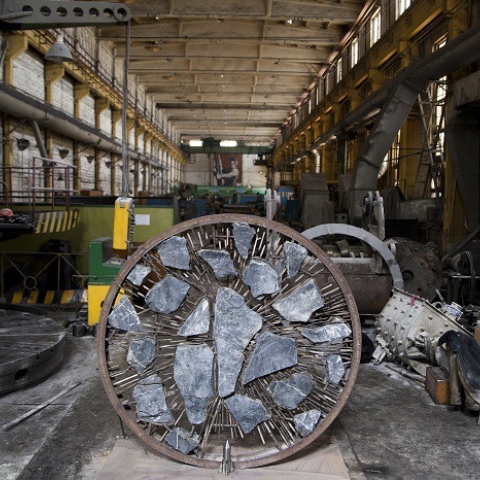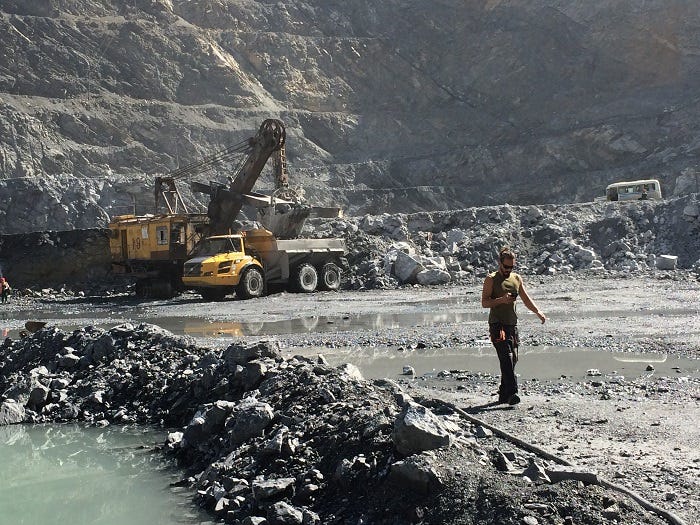-

DIARY OF THE THIRD INDUSTRIAL BIENNALE
-
Address:
-
Partners:
‘Our kind of guy’ Jacopo Mandich:
Art Residence in Satka

Observations of interpreter Margarita Glavcheva on how sculptures are made and friendship between nations appear.
The proposal to go to Satka was attractive and a bit daunting. I was glad to have the opportunity to immerse in the creative atmosphere of the 3rd Ural Industrial Biennale, to see by myself what is usually beyond the reach of spectators – creation of a piece of art, the work of the artist. I was expected to go along with the Italian sculptor Jacopo Mandich taking part in the Art Residence Program, to be his interpreter and to contact with the host side – representatives of Magnezit Group. The Group provided Jacopo with the required material and the place for work in one of its workshops. I had never visited any operating industrial plant or Satka before and I knew nothing about this town. My imagination made pictures of vast nature, austere Satka workers and ascetic daily routine to become my life for as long as 12 days.

Nearly two weeks are not much considering the creation of two sculptures (Jacopo decided to make two works: one for Satka and another for Ekaterinburg), so right after the arrival we went to select stones for future sculptures. In Satka, magnesite, a white-grey mineral used for production of refractory products, is mined. Its common complementary dike is dolomite, a black and more friable stone. The employees of Magnezit, Andrey Gennadyevich Kazantsev and Nikolay Nikolyevich Esenkov, took us to the dump, a large area where we saw float stones of various size lying under the open sky. Jacopo was happy! Quickly climbing the stone hills he was looking for the right stones. Having loaded the trunk of the company foreign-made car with massive blocks of magnesite and dolomite, we went to the maintenance and repair workshop where an area was detached for Jacopo to arrange his studio.

The arrival of an Italian sculptor was certainly a spotlight. Within several days we got acquainted with all workers of the workshop. It was of interest to everyone why Jacopo had come, what sculptures he was going to make, whether he had been to Russia before… Jacopo is very sociable and open, he gladly talked to the workers, answered numerous questions, gave leaflets with his sculptures. Gradually, a particular tradition was established: every day the workshop workers visited us one by one observing the progress of work, watching how Jacopo was embodying step by step his ideas into stone and metal. A lot of people told about themselves, about life in Satka, the women ‘fed’ Jacopo, some with candies, others with berries form their gardens. “A nice fellow, our kind of guy,” expressed their opinion about Jacopo the workers.
In general, the managers and the workers of Magnezit rendered all-round assistance to Jacopo, which included not only the provision of everything required for the work, but also solving unusual problems. Jacopo stated with the sculpture for Satka. Having worked on the model for a couple of days he saw a big round wheel in the workshop, a part of some industrial equipment, and a new idea of the sculpture with a similar ring as its core came to him. He could not use the working part of the equipment for the sculpture, but it was a matter of several hours to make a similar detail for him.

The work of a sculptor is not only creative but also physically hard. For two weeks we were actually living in the workshop: we came there at 8 o’clock in the morning and stayed till the evening. Jacopo worked, sawed and drilled heavy stones, welded iron rods together, and his skills and persistence made him respected by the workers of the shop. Jacopo always made his sculptured on his own but this time he acquired an assistant. One of the workers, Vladimir Leonidovich, took an active interest in Jacopo’s work from the very beginning. As we knew later, he can draw well and even had worked as an interior decorator in the workshop on a part-time basis. Certainly, he could not stay on the side-line and helped Jacopo whenever he had free time. Indeed, we could count on the assistance of Vladimir Leonidovich only during the first week of the work, because then he was to take a vacation. However neither we, nor him wanted to part, so we talked to the workshop managers and the vacation was shifted for one week.

At the weekend, when everybody had rest, Jacopo continued working. He started working on the sculpture for the biennale. Jacopo found a large stone for it made of two rocks: light magnesite and black dolomite. He sawed up the inside of the stone having taken away several layers each of which he sawed into cubes. The result was a kind of a box with refined sugar, only the hollow was not square but tapering to the bottom of the stone like open pits in Satka. While he was doing this I was in an adjacent area. It was impossible to stay near Jacopo; the air was full of white stone dust. When I returned, I saw a snowman: Jacopo was white from top to toe! It was impossible to return to the rest and recreation centre where we lived in such a form. A watchman came to the help: he gave Jacopo old track pants.

We liked to leave the workshop in the evening and go down the road. At twilight, the lines of industrial buildings disappeared against the background of the mountains, crickets were chirring. After a long day at the plant, the world around us returned to my senses. The nature of Satka is beautiful. The town is located on the hills which make the space multidimensional always opening new views and horizons. We returned to the rest and recreation centre with a self-explanatory name, La vita.

The sculptures created by Jacopo in Satka are very symbolic. You can feel the essence of the town in them, everything on what the life here is premised: mining, hard physical labour, penetration in rock, open pits which have become the name card of this area. The sculptures tell about the unity required to create, about the unity of everything and everyone as the essence of the world. They are full of social and metaphysical meanings like many works of Jacopo. The sculptor confessed, he would like the people of Satka, where a sculpture will be erected, and the people of Ekaterinburg, who will be able to see Jacopo’s work at the biennale, to interact with his sculptures, have the possibility to play with them, paint, take a piece of them as a keepsake, so as the creative activity of Jacopo work becomes an impulse for co-creation of the spectators.
P.S. I would like to express deep gratitude for warm hospitality and support to Evgeny Vasilyev, Vladimir Leonidovich, Vera Anatolyevna, Valentina and Mikhail, the employees of Magnezit maintenance and repair workshop no.2 who became our friends.
-
28.11 - 28.11
MY SATKA FESTIVAL WINS THE CONTEST OF CORPORATE VOLUNTEER PROJECTS
-
13.10 - 15.10
COOPERATION WITH VGIBL NAMED AFTER M.I. RUDOMINO
-
21.01 - 21.01
MAGNEZIT GROUP HAS BECOME A PARTNER OF THE TRETYAKOV GALLERY
